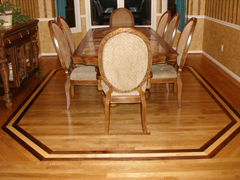Buildings, barns, ships and other structures made of wood often find a second life in wood flooring, cabinets, walls, and ceilings. And leading allergists agree that wood floors are the perfect choice for a healthy home.
The state-of-the-art technology and almost limitless choices of today’s stains, finishes, styles, and designs make wood flooring one of the most practical, easy-care and versatile floor coverings today. Maintained properly, wood flooring should never have to be replaced.
Advantages of Hardwood Flooring:
- Custom Hardwood (inlays, and medallions).
- Hardwood adds character and elegance to any room.
- If properly taken care of, hardwood will add value to any property.
- Is extremely popular among both designers and homeowners.
What is the difference between solid hardwood, engineered hardwood, and laminate?
Solid hardwood is s solid slab of wood that is typically 5/16″ to 3/4″ thick. In contrast, engineered hardwood consists of a veneer of real wood that is typically 0.7mm to 3.0mm thick. The veneer or wear layer of wood is pre-attached to an engineered wood sandwich layer that is designed to simulate plywood. Although the veneer layer is thinner than a solid wood, the veneer/sandwich layer construction gives the product superior dimensional stability over solid wood.
Typically, the installation of solid wood includes the two step plywood sub-floor/nail-down technique (3/4″) which is more expensive that the one step engineered wood floor that is installed using glue, staple or floating floor technique.
Laminate is a man-made flooring product that simulates the look of real wood. The high-definition image of real wood is laminated onto a dimensionally stable structural fiber core that is protected by a tough plastic film top wear layer. Typically, a laminate floor is installed using the floating floor technique.
Should I be concerned about moisture?
Prior to installing all floors, the installer should test the sub floor for moisture. Depending on the level of moisture present, a moisture vapor membrane may be required to remediate the condition.
I like the look of wood; however, I am concerned about scratches and denting.
Engineered and solid wood floors have several coats of aluminum oxide filled urethane finish. Aluminum oxide improves the abrasion resistance of the wood finish. The degree of resistance to scratch is determined by a combination of the flexibility and toughness of the finish coat. All coatings do not perform equally. Ask one of our associates to share their professional experiences. The degree of dent resistance is a combination of the finish toughness and the thickness of the wood wear layer. Even the toughest finish in the industry will not prevent a floor with a “thin” veneer or wear layer from denting. For those who are highly concerned about dent or scratch resistance, the industry offers hand scraped and pre-distressed wood flooring. Both hand-scraped and pre-distressed styles are gaining significant market share because any future scratches and dents add character to the product look.
Can I install engineered hardwood over tile?
Yes, a floating floor technique can be used. However, depending on the thickness of your joint lines, additional floor preparation will be required.
Special Points of Interest:
- Request a minimum engineered hardwood veneer thickness of 1.5mm.
- Engineered hardwood can be installed over most ceramic tiles using a floating floor technique.
- Always have the installer check the sub-floor for moisture.
- If denting is a big concern, ask for the hand-scraped or pre-distressed offerings.
- Ask for 8mm+ laminates for moderate to heavy use areas.
Carpet Depot
Family Flooring Center Home of in house financing

